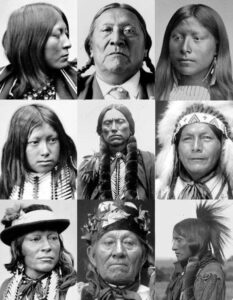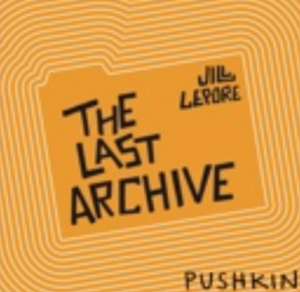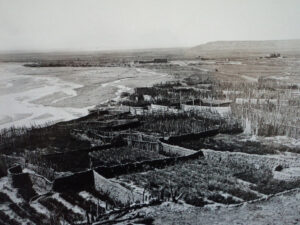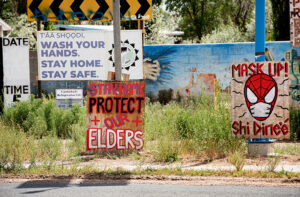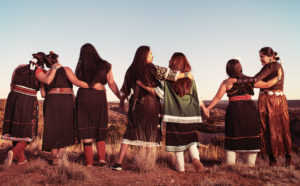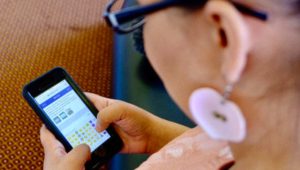Native Americans
#NativeAmericanHeritageDay
November 26, 2021“Native Americans are the keepers of traditions and defenders of our natural resources. This Native American Heritage Day, I honor our culture and our ancestors. At the Interior, we will continue to include Indigenous knowledge as we protect our lands for future generations.”
-Secretary Deb Haaland, 54th Secretary of the Interior, 35th generation New Mexican, Pueblo of Laguna Tribe
[Image: Lakota Man/Twitter]
‘That’s what gods do, they spin threads of ruin through the fabric of our lives, all to make songs for generations to come.’ -Anthony Doerr ‘Cloud Cuckoo Land’, p.439
Post
C
o
l
o
n
i
a
l
Stress
D
i
s
o
r
d
e
r
PCSD
“We’re still in the genocide. It’s still happening; we’re still doing it.”
Why?
We need to look at our “individual power in relation to the world.” -Rose
Rilke: “…blessed our those who stood quietly in the rain. Theirs shall be the harvest; for them the fruits. They will outlast pomp and power, whose meaning and structures will crumble. When all else is exhausted and bled of purpose, they will lift their hands, they have survived.”
Mixed-media artist Rose B. Simpson lives and works from her home at Santa Clara Pueblo in New Mexico.
(This piece was commissioned for the the Conspire conference, Center for Action and Contemplation, in New Mexico.)
https://www.rosebsimpson.com/about
[Rose B. Simpson, Holding it Together (detail), 2016, sculpture]
Mitákuye Oyás’iŋ
All our relations
The Last Archive
Jill Lepore, historian and Harvard professor
“Indigenous paradigm, a paradigm about relationships–all things are kin, rocks the skies, trees, family…”
https://podcasts.apple.com/us/podcast/the-last-archive/id1506207997?i=1000540005084
LATIMES
“The Indigenous Serrano Language Was All But Gone, This Man is Resurrecting It.”
When Ernest Siva was a boy on the Morongo Reservation in Riverside County, he listened to the music and stories of his ancestors, who had lived in Southern California long before the land was called by that name.
He recalls running around a ceremonial fire on the reservation at age 5 as a weeklong ceremony honoring those who had died the previous year culminated with the burning of images in their likeness. Dollar bills and coins were thrown into the fire in tribute as tribal elders sang songs reserved for special occasions. Siva and his cousin chased after the singed money that fluttered out of the flames, largely ignoring the traditional lyrics in the background.
The specific words and rhythms are now distant memories for the 84-year-old Siva, a Cahuilla/Serrano Native American.
Siva is working to change that. For the last 25 years, the Banning resident has been a tribal historian with the Morongo Band of Mission Indians.
CIVIL EATS
In the face of climate change and persistent droughts, a growing number of people from Zuni Pueblo in New Mexico and elsewhere are adopting the traditional farming practice.
Historic Zuni waffle gardens, circa 1919. (Photo courtesy of Kirk Bemis)
“It’s going to be difficult, but in the meantime, we still have to do what we can to find ways to adapt and live with it. And I think that the waffle gardens are one tool for us to make it through.”
(The) hope is for every household within the Zuni village to have a backyard garden, and that such a shift could cut a family’s need to shop for groceries in half.
“A small, 4-by-8 [foot] garden will get you a good four to five buckets full of corn, which is not enough to completely live off, but enough to feed our families, survive, and carry out our traditions.” He also thinks it’s important for the Zuni people to lessen dependence on grocery stores, which the pandemic showed are vulnerable to supply chain disruptions.
https://civileats.com/2021/10/26/resurgence-waffle-gardens-helping-indigenous-peoples-thrive-amid-droughts-grow-food-less-water/
Maria Popova
The Marginalian
“Ever since we climbed down from the trees, we have been looking up to them to understand ourselves and our place in the universe. “Nothing is holier, nothing is more exemplary than a beautiful, strong tree,” Hermann Hesse wrote a century ago in his sublime sylvan love letter, affirming that “when we have learned how to listen to trees, then the brevity and the quickness and the childlike hastiness of our thoughts achieve an incomparable joy.”
Centuries, millennia before Hesse — before Wangari Maathai won the Nobel Prize for her courageously enacted conviction that “a tree is a little bit of the future,” before scientists uncovered the astonishing language of trees, before Western artists saw in tree silhouettes a Rorschach test for what we are — the indigenous artists and storytellers of the Gond tribe in central India have been reverencing the secret lives of trees as portals into the inner life of nature, into the wildness of our own nature, into a supra-natural universe of myth and magic.”
The Secret Life of Trees: Stunning Sylvan Drawings by Indigenous Artists Based on Indian Mythology
Practicing ‘Full Presence’
November 20, 2020Navajo Nation
Learn how cultivating trust and community allowed Health Initiative to be effective partners in the region.
Dr. Sriram Shamasunder and his organization, HEAL Initiative, stood in solidarity with Navajo healthcare workers as they fought a COVID outbreak through the spring and summer.
This past summer, when the Navajo Nation was the site of one of the country’s worst coronavirus outbreaks, Dr. Sriram Shamasunder was at Chinle Comprehensive Health Care Facility in Arizona, caring for a Navajo elder in the respiratory care unit. When he was young, the patient had worked in the uranium mines on Navajo land, and he had spent decades drinking water contaminated with the radioactive element. He had poor baseline lung function, and now he had COVID-19. His family could not be there to comfort him. He was isolated and scared.
On harried rounds in the overwhelmed medical center, it was very difficult to be fully present. “I was moving fast. I was wearing goggles, a face shield, an N95 mask,” Shamasunder recalls. He couldn’t speak to the miner in his own language, and he wasn’t intimately familiar with the contours of the man’s life on the reservation. There was a gulf between them that Shamasunder, as his doctor, struggled to cross.
But Shamasunder had not come into the room alone. He was accompanied by Navajo nurses from the local community. “They would just lean over in his ear and speak to him in his own language,” Shamasunder says, “‘I won’t let you go.’ ‘I am from your community, and I’m here to stand with you.’ To bridge that gap is just so powerful.”
Signs encourage safety in the Navajo Nation. Photo credit: UCSF
I think there was a question all of us sat with. What does it mean to lead a purposeful, committed life? What does that look like?
What made HEAL so effective? It may have had something to do with the way HEAL responds to the problem Shamasunder has spent his entire career thinking about: How can the best care be delivered across the human boundaries of language, culture, gender, and religion that arise in our global community? After the technical training of medical school, can young health professionals be trained in the ineffable part of the practice, in leadership, advocacy, and justice?
How can they learn to show up in their full presence?
In May, a disheartening thread of stories about COVID-19 in the Navajo Nation was circulating. Per-capita infection rates soared. Congress had approved $8 billion in coronavirus relief for tribes around the country, but the money did not arrive as committed. It was a cruel echo of the disinvestment that had left the Navajo Nation — an area larger than West Virginia — with just 13 grocery stores and only some 20 ICU beds.
In the wake of this progress, UCSF is compiling a report on the efforts of HEAL and the volunteers in Navajo Nation. Shamasunder’s own reflections, unsurprisingly, have so far taken the form of notes and sketches of new poems that address the work of the health professionals in their full presence, affirming their spirit of partnership and solidarity. He wants to make sure the opportunity to explore those elements of the summer’s efforts is not overlooked — by the medical community, or by HEAL.
And the world must change.
This fall has seen COVID-19 case counts rise around the globe, and the Navajo Nation has not been exempt. In late October, with a surge in New Mexico taking hospitals in Albuquerque beyond their bed capacity, the reservation’s command-control structure re-engaged in planning for case management and potential patient transfers to hospitals all over Arizona and New Mexico. Just this week, after announcing that 34 Navajo communities have “uncontrolled spread” of the disease, the nation’s leadership instituted a three-week lockdown restricting nonessential activities. Shamasunder is trying to coordinate another team of nurses to travel down to Arizona and New Mexico to help. If he is needed, there is no question that he would return to the desert.
Full piece:
Restructuring the narrative.
April 14, 20185 Indigenous Women Asserting the Modern Matriarchy
They’re reclaiming the tradition of female leadership and turning the old, white, male-dominated perspective of history on its head.
It is precisely because this historical narrative is biased that righting this wrong isn’t as simple as cherry-picking the names of notable Native women and inserting them into textbooks or other media. In order to truly improve public understanding of important indigenous women in history, the entire narrative has to be restructured. And who better to do that than Native women themselves?
Today, contemporary indigenous women are taking the matter into their own hands and showing the public how to rethink, reframe, and relearn a new American-Canadian story that seamlessly incorporates the voices of indigenous women. These women are living in the tradition of their ancestors, whose societies and nations were often matriarchal. They are reclaiming the tradition of female leadership and turning the old, white, male-dominated perspective of history on its head.
The following are five Native American and First Nations women who are using their platforms in such profound ways that they are also, in a sense, making history.
Follow link:
http://www.yesmagazine.org/peace-justice/5-indigenous-women-asserting-the-modern-matriarchy-20180330
_______
Mountain West News Bureau
Nate Hegyi
“The data breach prompted a “Delete Facebook” movement that hasn’t really gained any traction.
That’s especially true in the Native American community, where Facebook is much more than sharing cat videos or keeping in touch with friends and family.
Social media is vital in Indian Country. It helps connect communities and reservations that are scattered across North America. Many are in rural, isolated places that don’t get a lot of attention from national media outlets.
Places like Pablo, a small, one-highway town in northwest Montana where Patrick Yawakie goes to college. He was an organizer for Native Lives Matter a couple years ago.
And in Indian Country that message can also be about mundane things — from community classes to bike donations and fundraisers. And then there are public service announcements that can actually save lives.
When a bad blizzard caused a state of emergency on the Blackfeet Reservation in Montana, people used Facebook to warn which roads were closed and to get food to needy families.
But as much as she loves Facebook, Lamb said indigenous communities would find other ways to get in touch and organize if it disappeared. She pointed to the founding of the American Indian Movement in the late 1960s.
“They didn’t have Facebook and I think they got a lot of things done,” she said. “So they would obviously adapt and change to the world and find a way. There’s always a way.”
Full article:
______
NPR
“A true account of the early 20th-century murders of dozens of wealthy Osage and law-enforcement officials, citing the contributions and missteps of a fledgling FBI that eventually uncovered one of the most chilling conspiracies in American history.”
“In his new book, Killers of the Flower Moon, David Grann describes how white people in the area conspired to kill Osage members in order steal their oil wealth, which could only be passed on through inheritance. “This was a culture of complicity,” he says, “and it was allowed to go on for so long because so many people were part of the plot. You had lawmen, you had prosecutors, you had the reporters who wouldn’t cover it. You had oilmen who wouldn’t speak out. You had morticians who would cover up the murders when they buried the body. You had doctors who helped give poison to people.”
Steve Inskeep and author David Gann:
